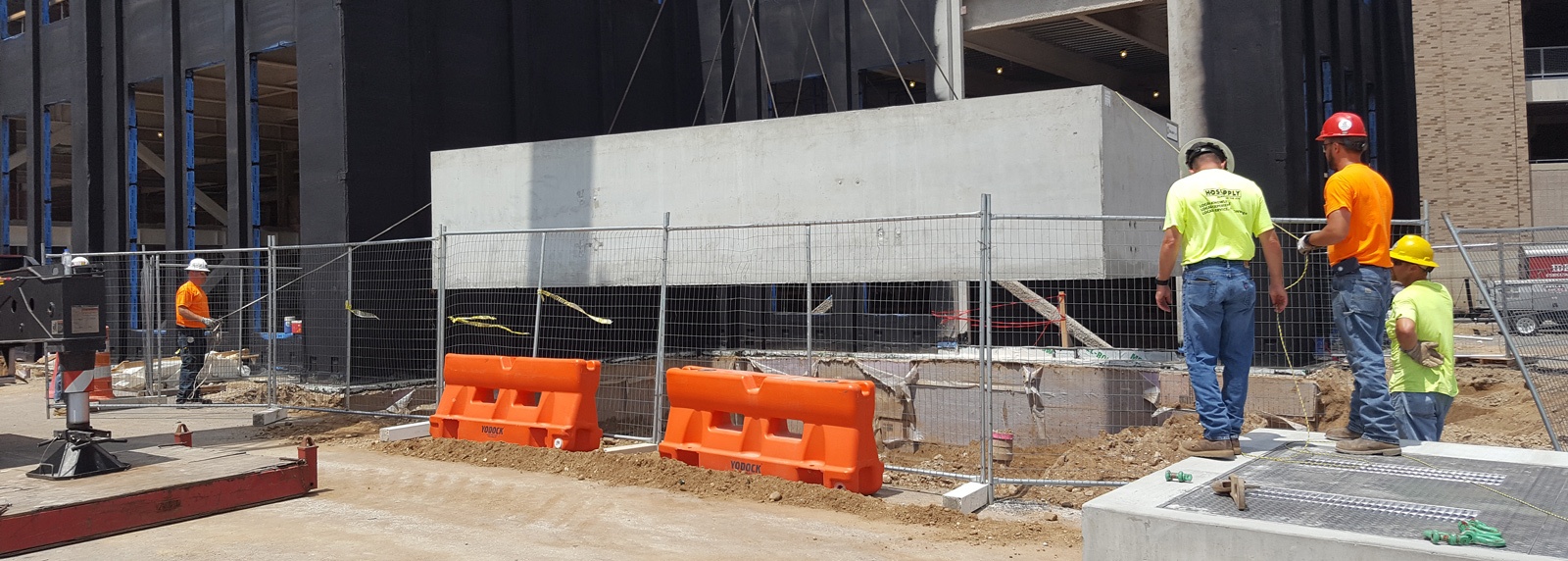In the years 70-80 AD, the Romans built the Coliseum using vaulted arches made of precast concrete to add strength to the building without adding excessive weight. Without concrete the Coliseum could not have been built. In the intervening 2,000 years, precast concrete has become the most commonly used building material in the world. For this reason it is often taken for granted and its nearly limitless possibilities are often overlooked.
QUALITIES
Architectural precast concrete is a tough, lasting, multipurpose material. It is about as durable as natural stone and is a much cheaper alternative. It is thermally efficient, fire resistant, creature proof, resists buoyant forces, and is rot proof, fungus proof and mildew resistant. It does not rust and it keeps water in – and out, and dampens vibration. With all of those qualities, it’s a wonder it isn’t used more frequently.
ADAPTABILITY
Precast concrete is what engineers call “structurally efficient,” meaning that a range of materials can be combined during manufacture to produce different properties.
- Precast can achieve high strengths and support heavy loads.
- It can be porous, dense or impervious.
- It can float or sink. It can be heavy or light. It can be thin.
- It can be fashioned into almost any shape. The accuracy and factory-controlled conditions in a precast factory are ideal for producing very precise, sharp details.
- Precast has the ability to span clear distances without propping.
- The convenience of making castings in large quantities allows builders to make an entire building to uniform specifications with relative ease.
- It is easily painted or stained and can be polished smooth.
PLUG AND PLAY. Precast is commonly manufactured with preinstalled utility services and fixtures. Manufacturing tolerances are so precise that watertight connections between pipes or sections are a snap, making precast perfect for underground applications.
HIGH RISE CONSTRUCTION. Lifting and placing finished precast pieces is far easier and safer than framing and pouring concrete level to level. Tall buildings up to 80 stories can be built with precast panels. The structural efficiency of precast can reduce floor depths by up to 4 inches. In a 60 story building, the height would be reduced by 20 feet, which means two additional stories.
ON SITE
 MINIMIZES WEATHER DELAYS. Precast products are manufactured in a controlled environment and delivered to the job site just-in-time (JIT), helping minimize downtime due to adverse weather conditions.
MINIMIZES WEATHER DELAYS. Precast products are manufactured in a controlled environment and delivered to the job site just-in-time (JIT), helping minimize downtime due to adverse weather conditions.
DELIVERED INSTALLATION READY. Precast pieces can be installed immediately, eliminating mixing, pouring, and constructing and dismantling molds on-site, and waiting for concrete to cure and dry. Quick installation allows other trades to begin work sooner, shaving valuable time off the construction schedule.
REDUCES JOB SITE IMPACT. Precast is the practical choice where construction space is at a premium because it requires no job-site footprint. Eliminating concrete making on-site also means a cleaner, safer job-site, greatly reducing disruption to the surrounding community including a substantial reduction in noise. This is particularly important on jobs involving rehabbing of hospitals and other large facilities that remain open for business.
ENVIRONMENT
The precast construction process is nontoxic and environmentally safe. Precast concrete is made from plentiful, local materials that come from natural and recycled sources that are widely available in all locations, making it a very sustainable construction material. Precast concrete building products correlate with at least four categories of LEED certification. Precast is a totally inert, emission-free substance. It does not emit any gases, toxic compounds or vocs (volatile organic compounds). It does not contribute to “sick building syndrome.” Precast products leave a smaller environmental footprint than other building methods thanks to increased recycling and reuse.
VALUE INVESTMENT
APPEALS TO INVESTORS. The aesthetic appeal and longevity of well-made precast structures and their resistance to both every day and extreme events makes them attractive to investors and occupants.
LOWER INSURANCE COSTS. With amazing structural properties, fire and mold resistance, and modularity and functional benefits, precast concrete structures may in some cases attract lower insurance premiums than those built with other construction materials. This can become particularly apparent in high-risk areas prone to tornados, hurricanes and floods.
LOWER MAINTENANCE COSTS. In comparison to many structures in exposed locations that need regular painting and upkeep to protect against corrosion, precast maintains its structural and aesthetic appearance without costly maintenance, a particularly advantage for roads, bridges and structures that cannot be easily accessed.
CONFIDENCE
Precast is a proven technology with a long history and a high-tech future. With a track record two-thousand years old, customers can rest assured when specifying precast products. Watch our video about precast concrete to learn more, including how precast structures are made.


